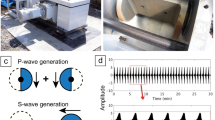Abstract
Monitoring and delineating the spatial distribution of shale fracturing is fundamentally important to shale gas production. Standard monitoring methods, such as time-lapse seismic, cross-well seismic and micro-seismic methods, are expensive, timeconsuming, and do not show the changes in the formation with time. The resistivities of hydraulic fracturing fluid and reservoir rocks were measured. The results suggest that the injection fluid and consequently the injected reservoir are characterized by very low resistivity and high chargeability. This allows using of the controlled-source electromagnetic method (CSEM) to monitor shale gas hydraulic fracturing. Based on the geoelectrical model which was proposed according to the well-log and seismic data in the test area the change rule of the reacted electrical field was studied to account for the change of shale resistivity, and then the normalized residual resistivity method for time lapse processing was given. The time-domain electromagnetic method (TDEM) was used to continuously monitor the shale gas fracturing at the Fulin shale gas field in southern China. A high-power transmitter and multi-channel transient electromagnetic receiver array were adopted. 9 h time series of Ex component of 224 sites which were laid out on the surface and over three fracturing stages of a horizontal well at 2800 m depth was recorded. After data processing and calculation of the normalized resistivity residuals, the changes in the Ex signal were determined and a dynamic 3D image of the change in resistivity was constructed. This allows modeling the spatial distribution of the fracturing fluid. The model results suggest that TDEM is promising for monitoring hydraulic fracturing of shale.
Similar content being viewed by others
References
Albaric, J., Oye, V., Langet, N., Hasting, M., Lecomte, I., Iranpour, K., Messeiller, M., and Reid, P., 2014. Monitoring of induced seismicity during the first geothermal reservoir stimulation at Paralana, Australia:, Geothermics, 52, 120–131.
Abdelfettah, Y., Sailhac, E., and Schill, H., P.D., 2016. Continuous MT monitoring for small fluid injection volume at Rittershoffen Geophysical Project, northern Alsace France: 23rd Electromagnetic Induction Workshop, Chiang Mai, Thailand.
He, Z., Hu, Z., Gao, Y., He, L., Meng, C., and Yang, L., 2015. Field test of monitoring gas reservoir development using time-lapse continuous electromagnetic profile method: Geophysics 80(2), WA127–WA134.
Hoversten, G. M., Commer, M., Haber, E., and Schwarzbach, C., 2015. Hydro-frac monitoring using ground time domain electromagnetics: Geophysical Prospecting, 63, 1508–1526.
Hoversten, G. M., Schwarzbach, C., Haber, E., Belliveau, P., and Shekhtman, R., 2017, Borehole to surface electromagnetic monitoring of hydraulic fractures: 6th International Symposium on Three-Dimensional Electromagnetics. Berkeley, California, USA, March 28–30.
Hu, W., Yan, L., Su, Z., Zheng, R. and Strack, K, 2008. Array TEM Sounding and Application for Reservoir Monitoring:. 78th Ann. Internat. Mtg, SEG, Expanded Abstracts,. 27(1), 634–638
Macnae, J., 1987, Imaging quasi-layered conductive structures by simple processing of transient electromagnetic data: Geophysics, 52(4), 545–554.
Maxwell, S. E., Cho, D., Pope T., Jones, M., and Leonard, J., 2011, Enhanced reservoir characterization using hydraulic fracture microseismicity. Paper SPE140449 presented at the SPE Annual Technical Conference and Exhibition, Texas, USA, 24–26 January. 2011.
Orange, A., Key, K., and Constable, S., 2009, The feasibility of reservoir monitoring using time-lapse marine CSEM: Geophysics, 74(2), F21–f29.
Peacock, J.R., Thiel, S., Reid, p., and Heinson, G., 2012. Magnetotelluric monitoring of a fluid injection: Example from an enhanced geothermal system: Geophysical Research Letters, 39(18), L18.
Peacock, J., Thiel, S., Heinson, G., and Reid, P., 2013. Time-lapse magnetotelluric monitoring of an enhanced geothermal system: Geophysics 78(3), B121–B130.
Peng R.H., Hu, X.Y., Liu, Y.X., and He Z.X., 2012. The feasibility study of time-lapse two dimensional magnetotelluric for reservoir monitoring: Chinese Geophysical Society, 2012, 112.
Raiche, A. P., and Gallagher, R. G., 1985. Apparent resistivity and diffusion velocity: Geophysics, 50, 1628–1633.
Rees, N., Heinson, G., and Krieger, L., 2016. Magnetotelluric monitoring of coal seam gas depressurization: Geophysics, 81(6), E424–E431.
Rees, N., Carter, S., Heinson, G., and Krieger, L. 2016, Monitoring shale gas resources in the Cooper Basin using magnetotellurics: Geophysics, 81(6), A13–A16
Strack, K. M., 1992, Exploration with Deep Transient, Electromagnetics: Elsevier, 373 pp.
Streich, R., 2016. Controlled-source electromagnetic approaches for hydrocarbon exploration and monitoring on land: Surveys in Geophysics, 37(1), 47–80.
Weckmann, U., Ritter, O., Haak, V., 2003. Images of the magnetoteluric apparent resistivity tensor: Geophysical Journal International, 155(2), 456–468.
Xie, X.B., Zhou, L., 2016. The application of long offset transient electromagnetic method in the monitoring of residual oil: Oil Geophysical Prospecting, 51(3), 606–612.
Xu, D., Hu, X.Y., Shan, C.L. etc., 2016. Landslide monitoring in southwestern China via time-lapse electrical resistivity tomography: Applied Geophysics, 13(1), 1–12.
Yan, L.J., Yang, S.F., Hu, W.B., 2001. Electromagnetic prospecting method and its application in carbonate area of South China: Petroleum Industry Press, Beijing.
Author information
Authors and Affiliations
Corresponding author
Additional information
The study was supported by NSFC (Grant No. U1562109 and 41774082), the National Major Research Plan (Grant No. 2016YFC0601100 and 2016ZX05004), and the Project of Scientific Research and Technological Development, CNPC (Grant No. 2017D-5006-16).
Yan Liang-Jun, Professor in Yangtze University, received his B.S. in Geosciences from China University, Wuhan in 1985, his M.S. in Geosciences from China University, Beijing in 1991, and his Ph.D. from Zhejiang University in 2002. He is interested in EM prospecting methods time.
Rights and permissions
About this article
Cite this article
Yan, LJ., Chen, XX., Tang, H. et al. Continuous TDEM for monitoring shale hydraulic fracturing. Appl. Geophys. 15, 26–34 (2018). https://doi.org/10.1007/s11770-018-0661-1
Received:
Revised:
Published:
Issue Date:
DOI: https://doi.org/10.1007/s11770-018-0661-1




